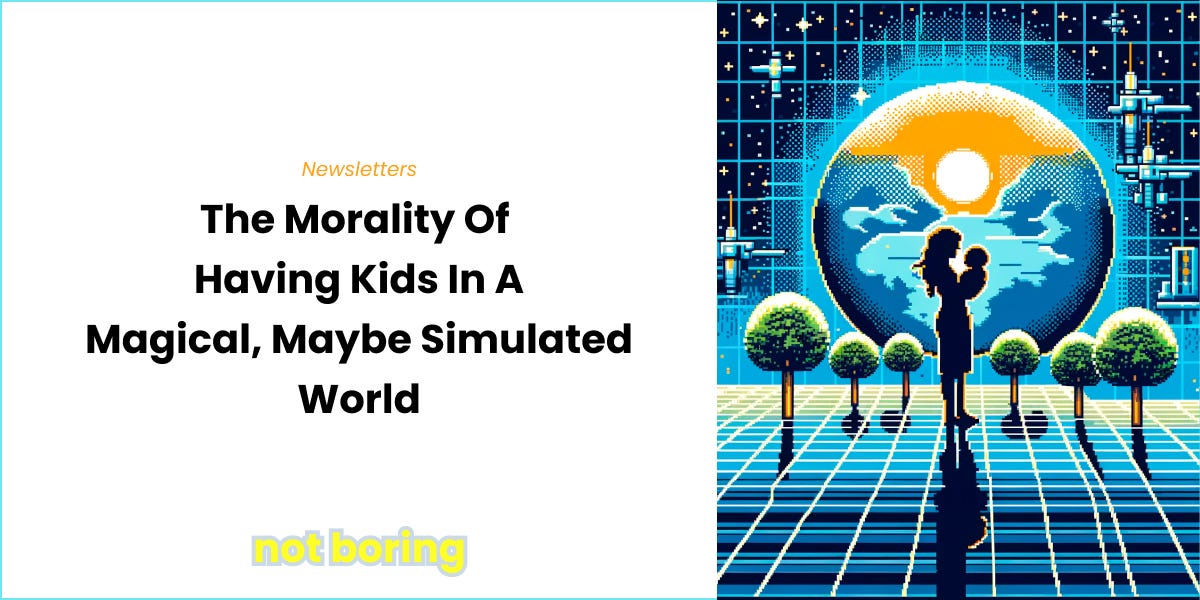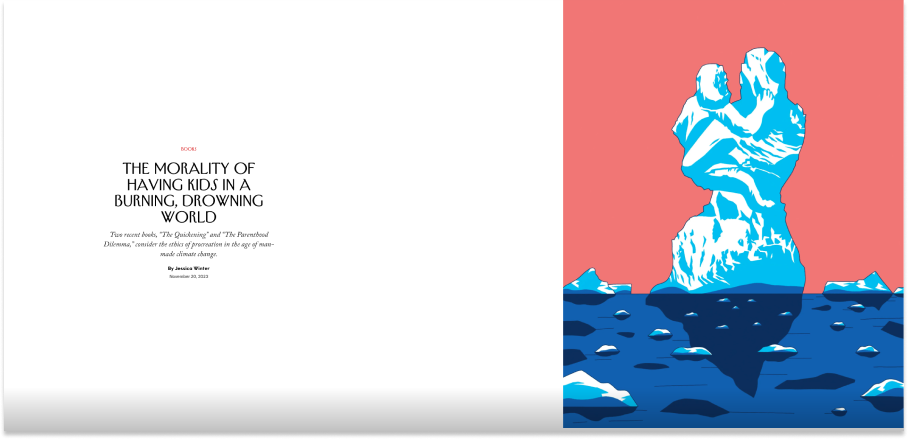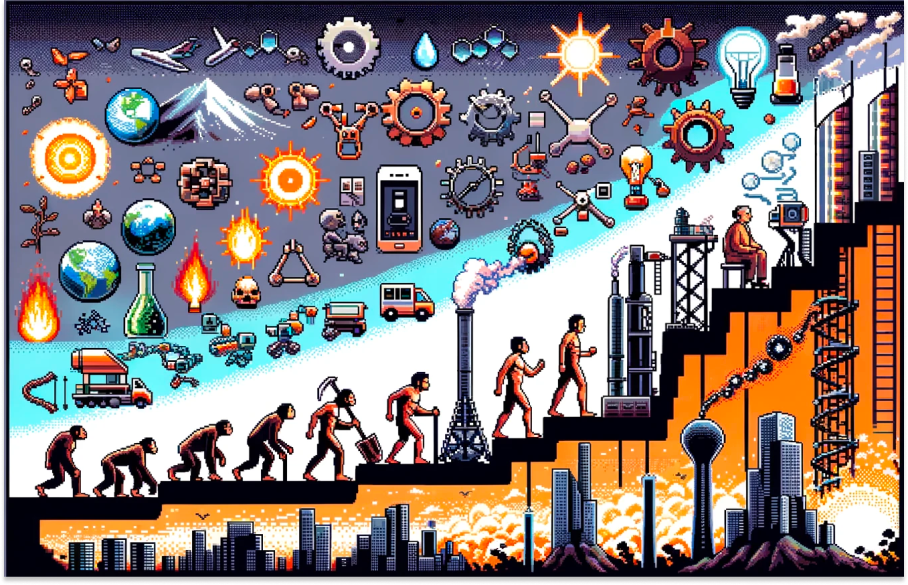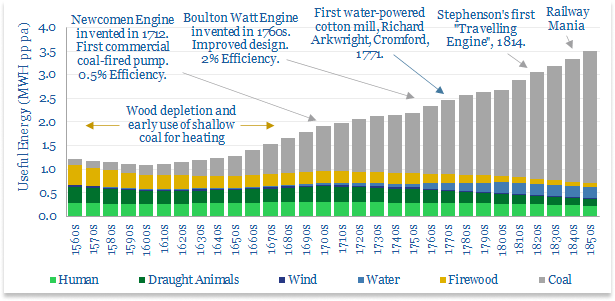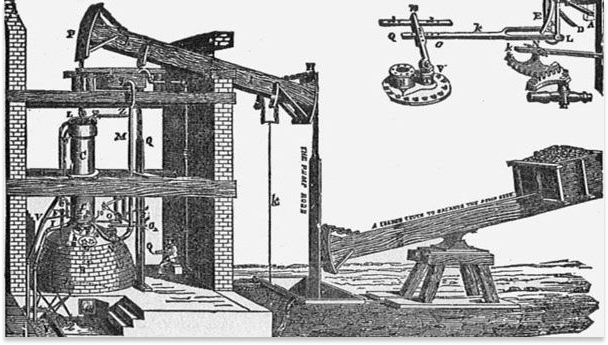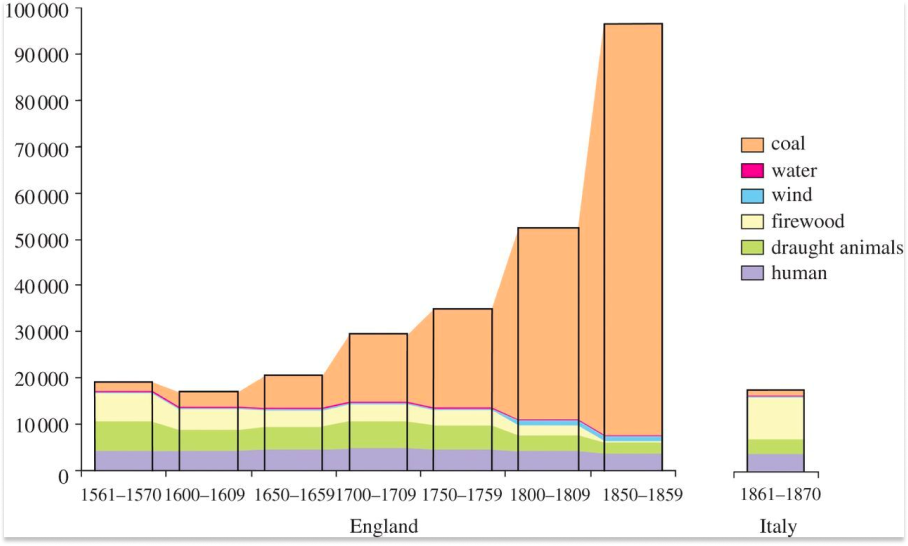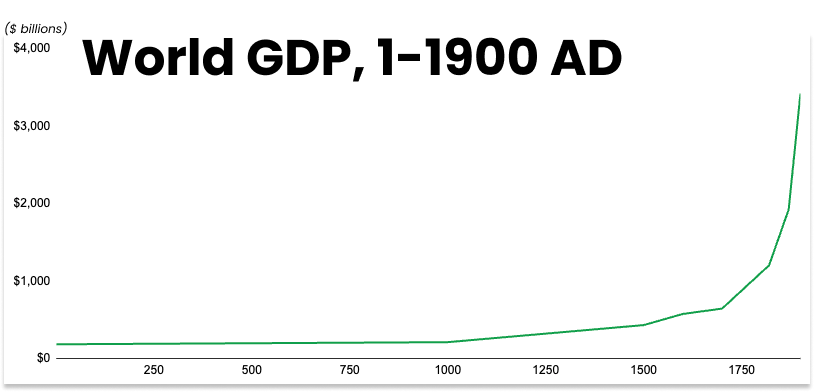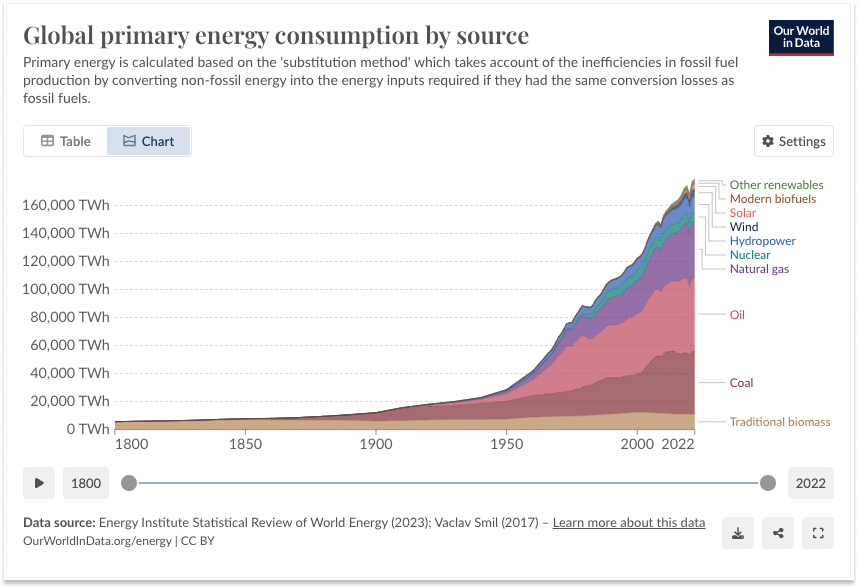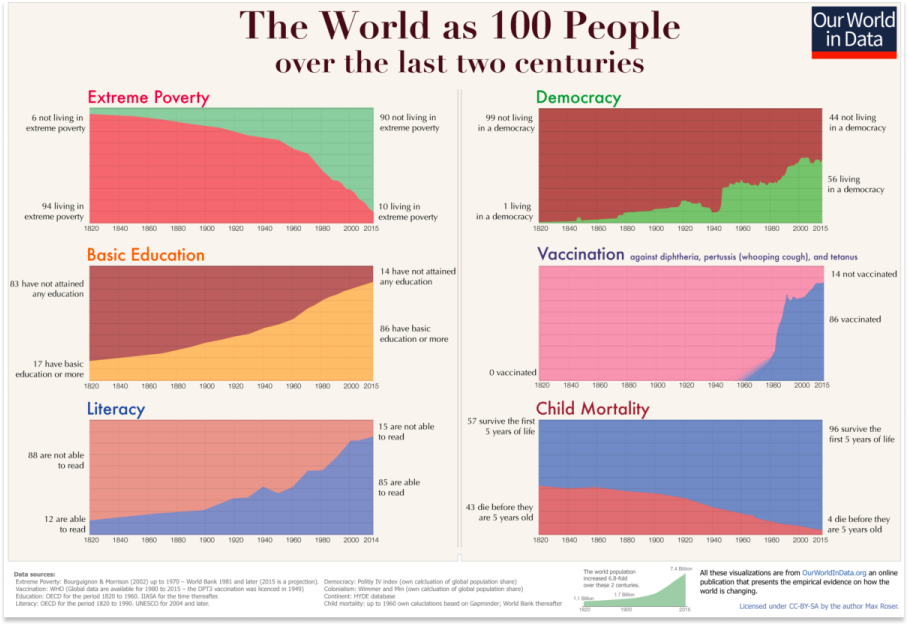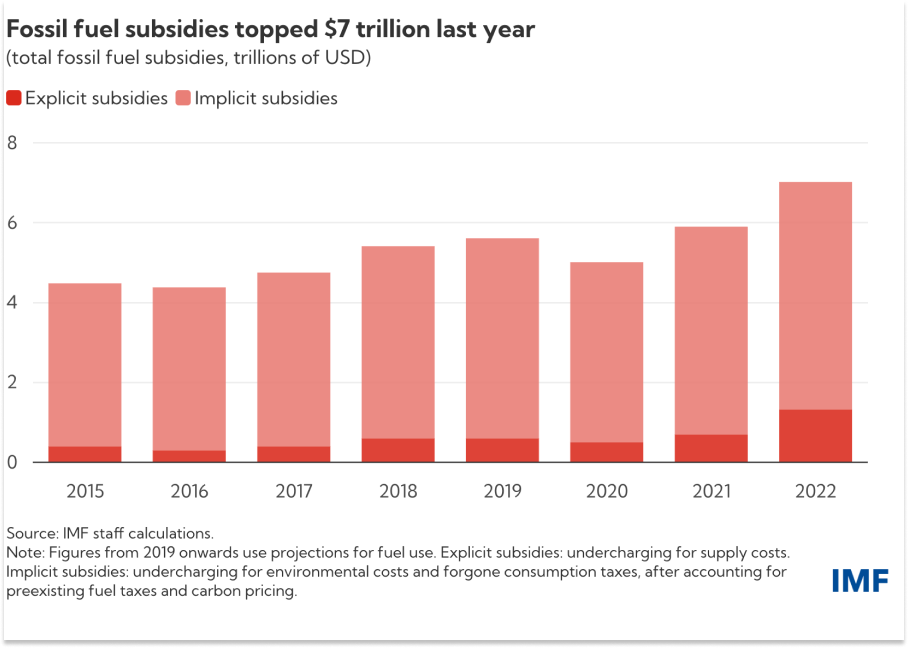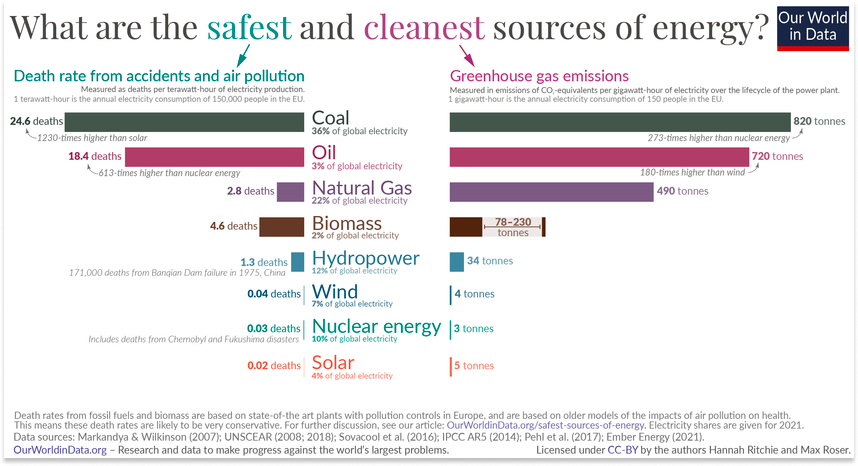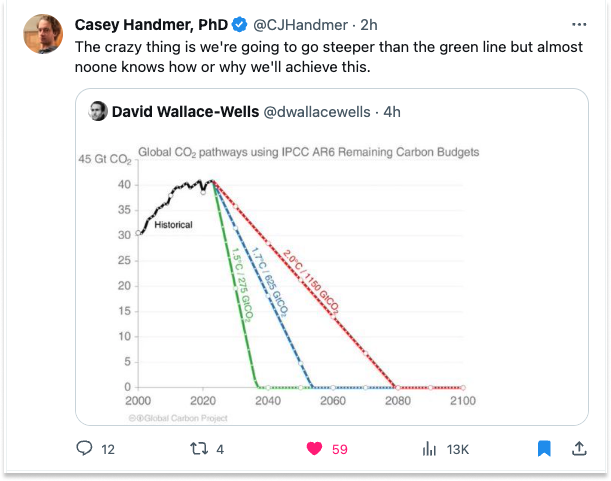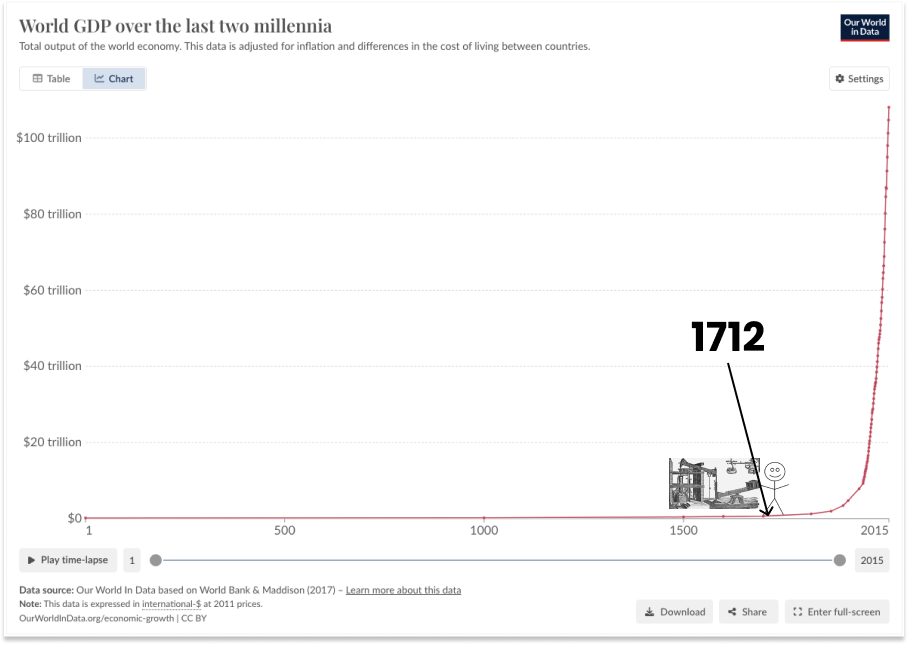The Morality of Having Kids in a Magical, Maybe Simulated World
The Morality of Having Kids in a Magical, Maybe Simulated WorldWhy the Climate Crisis May Be Proof We're In a SimulationWelcome to the 629 newly Not Boring people who have joined us since last week! If you haven’t subscribed, join 217,332 smart, curious folks by subscribing here: Today’s Not Boring is brought to you by… Alto Alto allows individuals to invest in alternative assets with their retirement funds through a self-directed IRA. It’s perfect for long-term investors in crypto, fine art, real estate, private credit, and more. Plus, given crypto’s recent surge, if you’re going to invest now, you might as well do so in a way that significantly reduces your tax burden in the future. Alto launched its alternative assets investment platform designed to streamline access for individual investors wanting to invest their retirement funds. Investing in alts with funds earmarked for retirement means you’re investing for the future with assets that have a longer time horizon and greater potential upside while also claiming tax benefits. Here’s an example: Let's say you make a $10,000 investment in venture capital with a Roth IRA. By the time you're 59 and a half, that investment has increased in value to $100,000. If you invested with non-qualified cash, you could pay up to 20% in capital gains taxes over the lifetime of this investment, meaning up to $18,000 of potential gains is lost to taxes. The RothIRA allows you to potentially avoid the entire tax liability, meaning $0 on the gains is lost to taxes. Of course, IRA rules and regulations apply, and you should seek advice from a tax professional when making investments. Even better, Alto just launched Alto Marketplace, a capital raise platform that connects individual accredited investors to leading funds and exclusive opportunities. Hi friends 👋 , Let’s get to it. The Morality of Having Kids in a Magical, Maybe Simulated WorldThere’s a thing that fancy magazines do every so often, which is to ask this Very Deep Question: is it morally OK to have kids when the planet is literally burning? I am here to tell you that that is an exceedingly dumb question. I am here to tell you that you¹ should have kids. There are a bunch of rational arguments you can make against the idea that it’s immoral to have kids in a drowning, burning world:
But it’s December now, and we’re in that annual wind-down period, so I figure why not get a little bit weird, try a different tack. It’s going to be one of these pieces: The other day, thinking about that Very Big Question, I tweeted something cryptic: “The climate crisis is the best proof I’ve seen that we’re in a simulation.” A few people, understandably, asked me what the hell I was talking about. The short, non-crazy version is this: climate change is a very real challenge with very real negative impacts on people and the planet. But climate change is solvable, and by solving it, we unlock the next phase of civilization’s growth. The longer, crazier version is longer and crazier. By the end, I hope you’ll see why I think that the kids are gonna be more than alright. Let me explain. ENERGY: The GameHuman history is the history of unlocking new energy sources to fuel new stages of civilization: food, fire, fossil fuels, then whatever comes next. Call it climbing the Kardashev Scale if you’d like. The more energy we put to productive use, the further civilization advances. If you squint, human history looks like a big, long game called ENERGY. The objective of ENERGY is to consume more energy in order to improve the human condition and ultimately light up the universe with intelligence. On each level, you need to maintain per capita energy consumption with the existing energy sources to not die and keep playing. Like any good game, ENERGY is full of challenges and bosses to defeat; defeating those bosses opens up new levels. Each level represents a new primary energy source. Humanity's progress in ENERGY has been the story of unleashing increasingly abundant, efficient, powerful sources of fuel in order to support more complex and advanced forms of society and technology and increase human flourishing. After beating food and fire, we’re currently on the Fossil Fuels level of the game, which we entered in the 18th or 19th century with the transition from wood to coal. We need to advance to the next level – Solar and Atomic Energy – before we deplete fossil fuels in order to keep the game going, or we get sent back to the beginning. To some, things look bleak, harder than they’ve looked in a long time. That’s OK; it means we’ve gotten to the Boss. We need to defeat the Boss to make it to the next level. The Boss is hard to beat. Transitions are hard. Things must have looked bleak during the last transition, too. The Coal QuestionThe conditions that led to the rise in coal consumption resemble the catalysts for the shift to clean energy: depletion of the old fuel source, and correction of an atrocity. The old fuel source was firewood. In the late 16th Century, the world’s largest economy, Britain, began to run low. This chart, from Thunder Said Energy, shows a drop in both firewood energy consumption and total energy consumption per person. “This is another reminder that energy transitions tend to occur when incumbent energy sources are under-supplied and highly priced,” the researchers wrote. The atrocity was African slavery. Around 1600, humans and draught animals were tied as the largest source of useful energy at 25%. Mercifully, by the time Britain banned the slave trade in 1807, human labor was down to 10%, and “by the time of the Abolition Act in 1833, it was closer to 5%.” As the old fuel source, firewood, began to run low and became expensive, people invented new ways to harness an existing but underutilized fuel source: coal. In 1712, an English blacksmith named Thomas Newcomen invented the atmospheric steam engine, the first commercially successful engine to use pistons and cylinders. The Newcomen Steam Engine both used coal as its source and pumped water out of coal mines, allowing humanity to mine more coal more easily, but it was still immobile and inefficient. Its 0.5% efficiency meant that only 0.5% of the energy input in terms of coal was converted into useful mechanical work. It was a starting point, though. By 1776, that annus mirabilis, James Watt and Matthew Boulton began selling their Boulton & Watt steam engine, which was not only 4x more efficient at 2% but also more versatile. It drove machinery in paper, cotton, flour, and iron mills, textile factories, distilleries, canals, and waterworks. It opened up new capabilities and new geographies. The Boulton & Watt steam engine helped kick off the next level in humanity’s growth: the Industrial Revolution. As William Jevons would note nearly a century later in The Coal Question, a more efficient steam engine paradoxically increased the rate of coal consumption significantly. And consume we did! During the Industrial Revolution, England nearly quadrupled its coal consumption over a century while more than tripling its total energy consumption. Advancing in ENERGY by unlocking new energy sources has implications beyond material things. It reshapes how civilization operates. For example, as machine labor grew in the west, the need for forced human labor shrunk. Slavery is as old as civilization. It was present as early as Mesopotamia around 3500 BC, and widespread in the ancient world across Europe, Asia, the Middle East, and Africa. Human labor, powered by food, was the primary source of useful energy. And then, within a century of the transition to an energy source that enabled machines to do labor only humans previously could, the practice was outlawed in the world’s two largest economies: America and Britain. To say that the steam engine led to the end of slavery in Britain and the US obviously ignores a number of important factors, but the Occam’s Razor is that once we had machines to do labor, we could afford to stop treating humans like machines. As Thunder Said Energy pointed out, human labor was one-fifth as big a contributor to the overall energy mix by the time Britain abolished slavery in 1833. In the United States, industrialization shifted power from the agrarian south to the urban north, and weakened the economic argument for slavery. People still worked in terrible conditions during the Industrial Revolution, but the economic/ethical balance of owning people flipped with the rise of machines. In ENERGY, humanity is roughly as ethical as it can afford to be. When food was scarce, it was acceptable to kill neighboring tribes to take their food. When machine labor was scarce, it was acceptable to enslave other human beings and force them to labor. Today, we allow billions of people to live in energy poverty because fossil fuels are a scarce resource. Around the world, children still do homework by candlelight once the electricity goes off for the day. Think of all the human flourishing capped by lack of energy. In the future, if we look back on our farming and eating animals as barbaric, it will be because we’ve learned to convert energy into food as delicious and nutritious as meat. We may look back on the fact that people were forced to spend most of their waking hours working jobs they hated in order to provide food and shelter for their families as horribly unethical, once we can afford to. We will certainly look back on energy poverty as unethical. One of the main reasons we progress in the game of ENERGY is in order to afford to become more ethical. Which is what happened in the last energy transition. By the turn of the 20th century in the west, slave labor was out and machines were in. And instead of killing the economy, World GDP began to go vertical. Forced by dwindling supply and growing demand, humanity was forced to unlock a new level in ENERGY, and we did. In the process, we overcame an atrocity. Right in the middle of that last energy transition, Thomas Malthus wrote his infamous Essay on the Principle of Population, in which he argued that population growth would inevitably outpace food production, leading to widespread famine and hardship. He was wrong, of course. He failed to predict human adaptability and resilience, and more specifically, failed to predict the technological innovations our ancestors would devise to solve the problem, including mechanized farming made possible by new machines and new energy sources to power them. Instead, we flourished. In the face of challenges, we transitioned from wood to coal, and added oil, gas, and capitalism to the mix, to boot, unlocking the next level. The Fossil Fuels LevelThis level – Fossil Fuels – has been awesome. We’re reaping its benefits to this day. Fossil fuels (and wood) still provide ~83% of global primary energy consumption. Though they get a bad rap now, fossil fuels have been miraculous for humanity. Since fossil fuels replaced human and animal labor and firewood as the world’s dominant sources of useful energy in the 18th century, the percentage of humans living in extreme poverty has declined from 94% to 8.5%. Democracy, education, vaccination, and literacy have risen, and child mortality has declined. Fossil fuels and their byproducts made modern computing possible. There would be no computers without fossil fuels, there would be no internet, and there would be no AI. Nor would there be solar panels or large wind turbines, both of which use petroleum-based components and energy-intensive manufacturing processes, or advanced geothermal, which uses techniques learned in drilling and fracking. The mining and refining of uranium ore for nuclear reactors, not to mention the materials in and construction of nuclear power plants, require fossil fuels and their derivatives. And commercial nuclear fusion would have no shot without the many fossil fuel-based inputs – from simulation software to materials to power requirements – that might make it possible. But, like wood three centuries ago, fossil fuels are dwindling, and their impact on the environment is a modern atrocity. We need to transition, but the transition represents the most complex global coordination problem in the history of humanity. Fossil fuels are just too good for business. This is why I said that the climate crisis is the best proof of a simulation I’ve seen: We can’t progress to the next level in ENERGY without widespread adoption of new sources of energy, and the climate crisis provides a catalyst to force that transition at just the right time. Proof of SimulationOK, proof of simulation is maybe a bit strong. But whoever set the starting conditions – god, aliens, physics, the universe itself – lined everything up too perfectly for this all to be a coincidence. Unbelievably, right as we're grappling with the threat of climate change, the next energy sources on our tech tree, such as solar, fission, and fusion, are clean and sustainable ones, exactly the kind we need to address climate change. What are the odds! The tech tree is this concept from strategy games like Civilization, a visual map of the technologies available as you progress through the game and make certain decisions. Start with raw materials and basic technologies, and work up to more powerful technologies. Each new technology requires mastery of the old; you can’t skip steps.
The raw materials required for the next set of energy sources have been there all along. The sun has always shone on the earth and Uranium, Deuterium, and Tritium have been here for billions of years, but without the accumulation of knowledge, machines, software, science, components, and energy we have today, we haven’t been able to turn them into usable energy. Now, right when we need them, we can. But we don’t just need these new energy sources to fight climate change. We need them for three reasons:
In other words, we would have needed to undertake this energy transition with or without climate change. The threat of climate change may be the only way that we can make it in time. Here’s what I mean. We’re going to need a lot more energy - and much denser energy – to unlock the next level of the game than fossil fuels can provide. Peak oil and gas estimates are always wrong – when the incentives are aligned, we come up with new ways to discover new resources – but fossil fuels are not infinite. That’s the main challenge: fossil fuel supplies are finite, and demand for energy is not. In fact, not long ago, the main concern around fossil fuels was not that they would destroy the planet, but that they would run out! In college, I took an Energy & Economics class, and the big theme was that we were going to run out of that sweet, sweet oil and gas very soon. Yesterday, Ben Thompson pointed out that in 2011’s Ready Player One, author Ernest Cline explained the book’s 2044 dystopia thusly (emphasis mine):
Just 12 years ago, the person who wrote the most futuristic book of the year was worried about an Energy Crisis, not a Climate Crisis! And thanks to intervening advances – AI, electric vehicles, heat pumps, robots, and more – we’re going to need much more energy than Cline could have predicted. In a recent conversation with Clay Dumas and Dr. Clea Kolster of Lowercarbon Capital for Age of Miracles, Clea told us that US electricity demand is expected to grow 5x by 2050, and that that expectation is probably conservative. In ten years, computing demand for electricity alone is going to be as big as all of US electricity demand is today. Climate impact or not, fossil fuels weren’t going to be enough to get to the next level, or even to keep us alive on this level for much longer. The transition to denser, more abundant fuels is necessary. But we have a problem, from the perspective of ENERGY: The Game: fossil fuels are really good today – they’re energy-dense, easily transportable, and cheap. Convincing the people and businesses that rely on fossil fuels to switch to less proven, less reliably, more expensive energy sources is a massive coordination problem, what SlateStarCodex would call a Moloch situation. Everyone is incentivized to keep using fossil fuels until it’s too late, and the next generation of energy technologies – solar, nuclear, and fusion – take a really long time to develop, scale up, and bring down the cost curve. Fossil fuels are still so important to our economy and quality of life that the IMF estimated that global governments spent $7 trillion – equivalent to 7.1% of global GDP – on explicit and implicit fossil fuel subsidies last year alone! Explicit fossil fuel subsidies of $1.3 trillion alone is higher than the high-end of the estimated budgetary impact of the Inflation Reduction Act’s climate provisions – $1.2 trillion – over the next decade. Fossil fuels still dominate. So the simulation creators programmed a little mechanism into the parameters:
Put another way, there is nothing next on the tech tree that is more dense and abundant than fossil fuels but just as highly emitting or moreso. There’s no superfuel that we could burn if we decided to say “fuck the planet, give me the superenergy.” Everything that comes next is clean. People will yell at me about the details here. Producing solar panels, wind turbines, geothermal rigs, nuclear power plants, and fusion generators produces some greenhouse gasses. But we’re talking a two order of magnitude drop in emissions; if we switched all energy production to these sources tomorrow, we’d be good on the climate front. These new energy sources – solar, wind, geothermal, nuclear, and fusion – address fossil fuels’ shortcomings from the perspective of the game. They’re abundant: renewables are renewable (save the panel and turbine replacement) as long as the sun shines and the wind blows, and there is enough fission and fusion fuel on the planet to last humanity billions of years. They’re energy-dense: nuclear fuel, like Uranium-235, is 2 million times more energy dense than fossil fuels, and fusion is 5-10 million times more energy dense! That energy density and abundance is useful for things we do today, like power generation and large-scale industrial processes, but it also opens up new possibilities. New levels in ENERGY – more dense, abundant fuel sources – translate to new civilizational capabilities. Coal powered the Industrial Revolution. Oil and gas opened up new means of transportation. Solar, fission, and fusion will power AI data centers, robots, electric vehicles, desalination, flying cars, cultivated meat, vertical farming, and any number of new inventions that we’ve yet to dream up. The point I’m trying to make is: we would have had to transition to these new energy sources in order to unlock the next level of civilizational progress no matter what. And we were going to run out of fossil fuels at some point. Without the climate crisis, we may have had an energy crisis. The reason I say that the climate crisis is proof of simulation is that somehow, right when our energy usage is on the cusp of destroying our planet, forcing us to use new energy sources, for the first time in human history, the next set of energy sources on the abundance/density ladder are clean. You can’t make this shit up! Solar, nuclear, and fusion were developed because they did something better than the energy sources humanity had developed to date, because they might be the next step on the tech tree, the next level in ENERGY. It is a happy accident of history, a great coincidental gift from the universe, or an intentionally designed feature of the simulation that they all turned out to not kill the planet. But without the climate crisis, their development and installation would likely have been too slow to matter. After initial military and space applications in the US, solar was relegated to Japan, which as a remote island nation with limited natural resources needed a way to gain energy independence. It was only when Germany turned to solar as part of the clean energy movement in the 1970s, and when China began manufacturing for Germany at scale, that solar began to ride the cost curve down towards competitive prices. For two decades, climate-related subsidies around the world continued to drive down costs and drive up installations. Without the climate crisis, solar installs would not be where they are today. Nuclear fission, too, started with military applications, namely the atomic bomb. After an initial wave of excitement and nuclear plant installations in the 1960s, a number of factors – environmentalists, economics, slowing energy demand, and disasters – slowed new installs to a trickle. Germany even shut down its nuclear plants and replaced them with coal. Fortunately, at the COP28 climate summit, the United States led a group of nations in committing to triple nuclear energy capacity by 2050, “recognizing the key role of nuclear energy in reaching net zero.” Without the climate crisis, “environmentalists” may have succeeded in killing nuclear energy. And then there’s fusion, the energy source furthest along the tech tree. Fusion has been a promising research project for nearly 80 years with no commercial success to show for it. At the turn of the millennium, most of the world’s research efforts and dollars were channeled into one promising but glacially slow project – ITER – with a projected timeline of 2035-2040. What’s happened since, however, is for all intents and purposes miraculous. A number of other branches of the tech tree – magnets, simulation software, and controllers, to name three – have all hit a point at which commercial fusion has become much more viable in the near-term. At the same time, government programs like the Department of Energy and ARPA-E and climate-focused investors like Bill Gates’ Breakthrough Energy and Lowercarbon Capital, have begun to pour significant dollars into private companies in the space. In 2012, investors put $154 million into six companies. In 2021, they invested $3 billion into 20 companies. Currently, there are roughly 80 companies pursuing fusion energy. We have Age of Miracles episodes on fusion coming out over the next two weeks, and after talking to founders, I am convinced that one of the companies we’ve spoken to will commercialize fusion sooner than the world expects. The question is just: which one, or how many of them? The technology, “always 30 years away,” may arrive in as little as five years, just in the nick of time. Without the climate crisis, private fusion companies may not have gotten the talent or funding they needed to achieve fusion; now, it’s just a matter of who and when. We haven’t defeated the boss yet. There is a gigaton of work left to be done to avoid warming the planet by more than two degrees celsius. COP28 agreements are not installed capacity. Fusion generators still need to produce more energy than it consumes, and then we need to manufacture a lot of them. We still need to use all three technologies, and more besides, to pull CO2 from the atmosphere. If anything, humanity needs to put even more effort into the energy transition. If the Climate Crisis is proof of a simulation, it’s only as a signal to humans to work harder to ensure we make the transition happen. It won’t happen by itself. But at this point, it seems… very doable. Casey Handmer, the Terraform Industries CEO who we had on a recent episode of Age of Miracles, recently tweeted that we’ll get to net zero before the most optimistic expectations, despite the fact that “almost noone knows how or why we’ll achieve this.” He’s betting you can use solar to pull CO2 from the air and turn it into synthetic fuels. The grand challenge of, and incentives to prevent, the climate crisis have pulled in some of the smartest people in the world to use all the tools at humanity’s disposal to avoid disaster, and in the process, beat the boss and advance to the next level of ENERGY: The Game. Have KidsLook, I tried to simplify millions of years of history and some very complex, multi-causal events into one, clean narrative. I’m missing important details, even getting some wrong. But from this zoomed out view, the period that we’re living through isn’t a tragedy, it’s a trial, and it will be a triumph. Without the climate crisis, we would likely have ridden fossil fuels until it was too late. At that point, we wouldn’t have been able to power a growing population or increasingly powerful machines. We might not have had the resources to develop, produce, and scale the next generation of energy sources at all. Without the climate crisis, the future might have been bleak. That zero-sum, negative growth world would have been a bad one to bring kids into. Because of it, the world has accelerated the development and deployment of technologies like solar, fission, and fusion. We’re not out of the woods, but we have the tools to get out. The moment we begin to reverse the effects of climate change, we’ll have broken through to the next level, one in which we can manufacture energy and consume as much of it as we would like without fear of killing the planet. That is enormous and unprecedented. There will certainly be new problems and challenges. Utopia isn’t real, and we wouldn’t want it to be. But if history is a guide, the next level in ENERGY will transform and improve society in ways that are impossible to predict from our current vantage point, just as it would have been impossible to sketch the Industrial Revolution by looking at the Newcomen Steam Engine. If we get this right, our kids will live in a world that’s more abundant and more ethical than the one we inhabit today. They’ll look back at 2023 the same way we look back at 1712: wouldn’t want to live there, but thankful for the contributions of the people who did. Climate change is real. It’s our current Boss. Defeating it will require deft gameplay from millions of people, governments, and businesses. But it doesn’t spell inevitable doom, either. Humans are incredibly adaptable, and against all odds, we’ve created exactly the right tools to defeat it and unlock the next level at exactly the right time. Having kids isn’t the problem; it’s the solution. It’s exactly because people who lived in much worse conditions than we do decided to have kids that we have the ultimate weapon in this game: human creativity. Whatever challenges await on the next level, we’ll need all the kids we can get to solve them. So don’t listen to the doom and gloom. It’s counterproductive, depressing, and evil. It prioritizes clicks over your happiness and uses fear to sell ads. The people pretending to be ethical by being pessimistic are not the good guys; they’re villains in this game. But villains can be useful, too. They’re part of the game. If that fear has motivated some of our best people to join the fight to beat the boss and unlock the next level, humanity is better off for it. Just don’t let it depress you into hopeless inaction, right when things are about to get really good. Don’t let it stop you from bringing kids into this world. If we’re lucky, we might be alive to experience some of the wonders of this next level. I certainly hope to be. But I’m almost certain that our kids will be, and I am so excited for them. What a time to be alive! 1 Not all of you, of course. You might have very good non-climate-related reasons to not have kids. You might be too young or too old. You might not have the means to add another mouth to feed at the moment. There are a number of valid reasons to not have kids right now, but the climate isn’t one of them. |
Older messages
Weekly Dose of Optimism #71
Friday, December 1, 2023
GLP-1s, Loyal, Material Discovery, Fervo,AI Optimism, Energy
Narrative Tug-of-War
Tuesday, November 28, 2023
How to read EA v. e/acc
Weekly Dose of Optimism #70
Friday, November 24, 2023
Ceasefire, Q*, Deep learning Cancer Detection, Warp Speed Learnings, Nuclear Wins, Starship Separation
OpenAI & Grand Strategy
Wednesday, November 22, 2023
Altman, Augustus, and Preparing for Tech's Coming Battles
Weekly Dose of Optimism #69
Friday, November 17, 2023
CRISPR, Batkid, GraphCast, Nuclear Pledge, Starship, AoM5
You Might Also Like
🔮 $320B investments by Meta, Amazon, & Google!
Friday, February 14, 2025
🧠 AI is exploding already!
✍🏼 Why founders are using Playbookz
Friday, February 14, 2025
Busy founders are using Playbookz build ultra profitable personal brands
Is AI going to help or hurt your SEO?
Friday, February 14, 2025
Everyone is talking about how AI is changing SEO, but what you should be asking is how you can change your SEO game with AI. Join me and my team on Tuesday, February 18, for a live webinar where we
Our marketing playbook revealed
Friday, February 14, 2025
Today's Guide to the Marketing Jungle from Social Media Examiner... Presented by social-media-marketing-world-logo It's National Cribbage Day, Reader... Don't get skunked! In today's
Connect one-on-one with programmatic marketing leaders
Friday, February 14, 2025
Enhanced networking at Digiday events
Outsmart Your SaaS Competitors with These SEO Strategies 🚀
Friday, February 14, 2025
SEO Tip #76
Temu and Shein's Dominance Is Over [Roundup]
Friday, February 14, 2025
Hey Reader, Is the removal of the de minimis threshold a win for e-commerce sellers? With Chinese marketplaces like Shein and Temu taking advantage of this threshold, does the removal mean consumers
"Agencies are dying."
Friday, February 14, 2025
What this means for your agency and how to navigate the shift ͏ ͏ ͏ ͏ ͏ ͏ ͏ ͏ ͏ ͏ ͏ ͏ ͏ ͏ ͏ ͏ ͏ ͏ ͏ ͏ ͏ ͏ ͏ ͏ ͏ ͏ ͏ ͏ ͏ ͏ ͏ ͏ ͏ ͏ ͏ ͏ ͏ ͏ ͏ ͏ ͏ ͏ ͏ ͏ ͏ ͏
Is GEO replacing SEO?
Friday, February 14, 2025
Generative Engine Optimization (GEO) is here, and Search Engine Optimization (SEO) is under threat. But what is GEO? What does it involve? And what is in store for businesses that rely on SEO to drive
🌁#87: Why DeepResearch Should Be Your New Hire
Friday, February 14, 2025
– this new agent from OpenAI is mind blowing and – I can't believe I say that – worth $200/month

